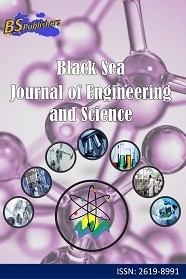
Black Sea Journal of Engineering and Science
Yazarlar: Ayşe ÖLMEZ, Şenol AKIN
Konular:Mühendislik
DOI:10.34248/bsengineering.639797
Anahtar Kelimeler:Suat Uğurlu,Hasan Uğurlu,Dam,Stomach contents analysis,Spatial and temporal variation,Feeding habits
Özet: In this study, spatial and temporal feeding habits of Squalius cephalus (L., 1758) sampled in the Suat and Hasan Uğurlu Dam Lakes and the river areas above and below the dams was investigated by stomach contents analysis. For that purpose, the sampling was performed at 4 different stations: The first station, the Dam Exit (DEX) river areas; the second, Suat Uğurlu Dam Lake (SUDL); the third, Hasan Uğurlu Dam Lake (HUDL) and the fourth, the Dam Entrance (DEN). A total of 332 individuals of Squalius cephalus were sampled during the four seasons. Empty stomach ratio was 54.41%. Accordingly, the highest number of empty stomach was observed in autumn (for 60 individuals). According to stomach contents analysis, a total of 37 different prey species belonging to 6 main groups were identified. Of the identified prey species, insects group was the most preferred feed source (39.5%), followed by Chlorophyta (12.48%), Bacillorophyta (9.93%), aquatic plants (8.04%), detritus (5.57%) and Crustaceae (1.27%), respectively. The dominant food item in spring were Bacillariopyhta (3.49 ml), Chlorophyta (4.52 ml) and insects (14.44 ml) while Chlorophyta (1.93 ml), insects (1.38 ml) and detritus (1.41 ml) in summer. It was determined that insects and aquatic plants predominated stomach of S. cephalus in autumn, whereas they mostly fed on insects and preferred plant originated Bacillariohyta group in winter. Dams caused changes in the number of fish and food sources along the river. S. cephalus fed on insects, Bacillariophyta and Chlorophyta in DEX and SUDL; detritus, insects, Bacillariophyta in HUDL and aquatic plants, Bacillariophyta in DEN. In conclusion, it was observed that S. cephalus preferred both animal and plant materials during four seasons. More S. cephalus were captured in the river areas at the outlet of the dams and the variety of food sources consumed has been characterized more in their SUDL and HUDL.